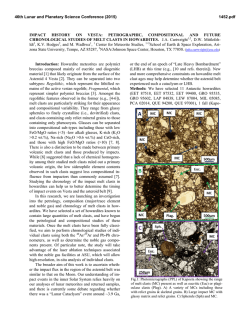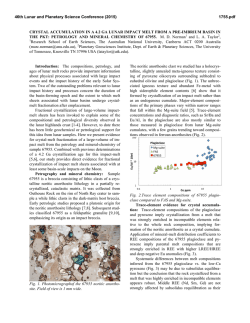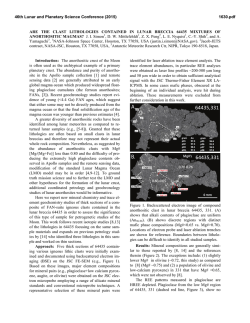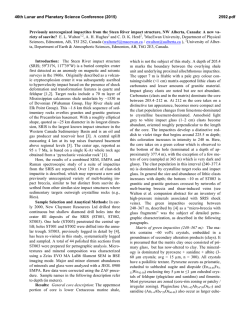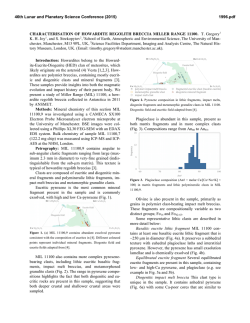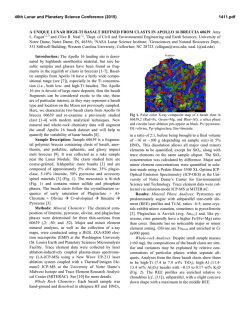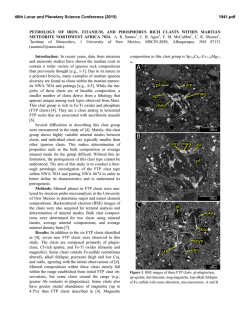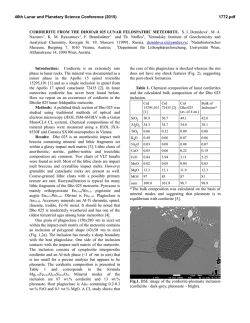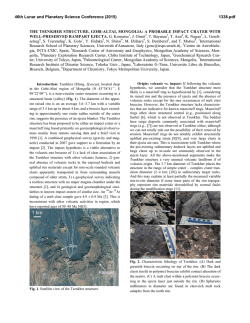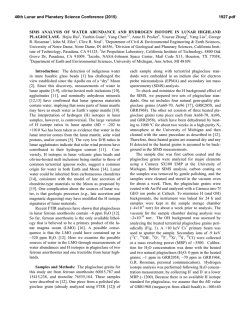
Petrography and Geochemistry of Lunar Meteorite Dhofar 1983
46th Lunar and Planetary Science Conference (2015) 2612.pdf PETROGRAPHY AND GEOCHEMISTRY OF LUNAR METEORITE DHOFAR 1983. P. J. A. Hill1; G. R. Osinski1,2; N. R. Banerjee1; A. Ali1; R. L. Korotev3; S. Nasir4 1Department of Earth Science and Centre for Planetary Science and Exploration (CPSX), University of Western Ontario, London, ON, Canada. 2Department of Physics and Astronomy, University of Western Ontario, London, ON, Canada, 3Department of Earth and Planetary Sciences, Washington University, Saint Louis, MO, USA. 4Earth Sciences Research Center, Sultan Qaboos University, Muscat, Oman. Introduction: Dhofar 1983 is a new lunar meteorite from Dhofar, Oman classified as a feldspathic regolith breccia due to the abundance of anorthosite and presence of spherules [1]. An image of the thin section is shown in Figure 1. Fig. 1: Scanned thin section of Dhofar 1983 with the darker domain outlined. Petrography: Dhofar 1983 is a feldspathic regolith breccia containing predominately anorthosite and impact melt rock clasts within two distinct domains. Of the two domains a fine-grained, brown mesostasis, likely glass is the most abundant; however, minor amounts of a darker domain rich in impact melt rock clasts is also present. The darker domain is outlined in Figure 1. Round spherules are present within the domains. The 4 main types of clasts identified within Dhofar 1983 are: anorthosite, clast-rich impact melt rock (impact melt breccia), gabbro, and mineral fragments. The anorthosite clasts are dominated by inequigranular, subhedral grains of plagioclase ranging from 100 µm to 300 µm. In some clasts the coarse grains of plagioclase are surrounded by finer grained plagioclase (<50µm). In most of these clasts the plagioclase has a poikilitic texture with inclusions of subhedral to anhedral clinopyroxene and occasionally olivine. The size of these clasts varies from 50 µm to 1000 µm. Compositionally, these clasts are dominated by plagioclase and most are categorized as anorthosites; however, 10% have more clinopyroxene or olivine suggesting they are noritic anorthosites or troctolitic anorthosites. The second most common clasts are impact melt rock clasts. Three types of these clasts are present: homogenous impact melt rock, clast-rich impact melt rock (impact melt breccia), and anorthositic clast-rich impact melt rock (impact melt breccia). The impact melt rock clasts are homogenous, brown-black rounded clasts of melt rock. The clast-rich impact melt rock clasts commonly has coarse, subhedral grains of plagioclase and clinopyroxene surrounded by impact melt rock. Greater than 90% of the fragments within these breccias are plagioclase except in one large clast that has slightly more clinopyroxene (35% cpx; 60% plag; 5% olivine). These clast-rich impact melt clasts are representative of a breccia-in-breccia texture. The anorthositic clast-rich impact melt rock clasts consists of microporphyritic, bladed grains of plagioclase surrounded by interstitial melt. Most of the clasts are between 100 µm to 500 µm but some exceed 1000 µm. Gabbroic clasts are much less abundant than clast-rich impact melt rock and anorthosite clasts. These clasts are dominated by subhedral clinopyroxene grains that have a subophitic texture with fine-grained plagioclase amongst coarser clinopyroxene grains. The clinopyroxene varies in composition throughout the thin section, with pigeonite and orthopyroxene observed as resinous, brown-red grains within the grabboic clasts. There are also grains of olivine present (<5%). Compositionally these clasts would be classified as olivinebearing anorthositic gabbro. Cutting across the sample are veins of calcite and sulphates indicative of terrestrial weathering. Mineral Chemistry: The anorthosite present in the clasts of Dhofar 1983 ranges in composition from An 91–98 (n=52). Pyroxene and olivine chemistry of Dhofar 1983 is shown in Figure 2. When the anorthite composition of the plagioclase and the Mg # of coexisting mafic phases (olivine and pyroxene) are compared to the compositional fields outlined by [2], Dhofar 1983 has components within the ferroan anorthosite (FAN) field, the Mg-rich rocks suite, and intermediately between the two. The Fe-Mn ratios of mafic phases in Dhofar 1983 correlates with oxidization state of the Moon as outlined by [3]. 46th Lunar and Planetary Science Conference (2015) 2612.pdf (a) REE/C1 100 10 Yamato 793274 [10] Calcalong Creek [11] (b) Dhofar 1673 [8] Dhofar 1983 1 La Ce Nd Sm Eu Tb Yb Lu Element Fig. 2: (a) The composition of pyroxene observed in Dhofar 1983 (n=59). (b) The composition of olivine observed in Dhofar 1983 (n=18). Isotope Geochemistry: The triple oxygen isotope composition of Dhofar 1983 was determined using 2 runs; both of which plot proximally to the Terrestrial Fractionation Line (TFL) as shown in Figure 3. The method for reporting the triple oxygen isotope data provides an accuracy and precision better than ± 0.1‰ [4]. The oxygen isotope composition of Dhofar 1983 is similar to other lunar meteorites [5-7] (Fig. 3). Fig. 3: The oxygen isotopic composition of Dhofar 1983 plots along the terrestrial fractionation line similar to other lunar meteorites [5-7]. Bulk Chemistry: The high concentration of anorthosite within this sample is reflected in the high Al2O3 content and low FeO content of the sample. The anorthosite is also reflected in the REE pattern for Dhofar 1983, where a positive Eu-anomaly is observed as seen in Figure 4. The REE plot is most similar to other feldspathic lunar meteorites such as Dhofar 1673 [8]. The Sc-Fe ratio of Dhofar 1983 (3685) is also within the range of highland lunar meteorites. In addition to its REEs, other incompatible elements, such as Th (0.37 ppm), are also lower in Dhofar 1983. The siderophile elements Ni and Ir for Dhofar 1983, 197 ppm and 8.7 ppb respectively, indicate the presence of meteoritic components [9]. Fig. 4: C1 normalized REE plot for Dhofar 1983, Yamato 793274 [10], Calcalong Creek [11], and Dhofar 1673 [8]. Discussion: The bulk composition and petrography of Dhofar 1983 is indicative of a feldspathic lunar meteorite. The low concentration of Th and other incompatible elements suggests there is no evidence for a KREEP terrain component. This suggests that the source of Dhofar 1983 would not have been proximal to the Imbrium Basin. Dhofar 1983 was found within 400 m of the lunar meteorite Dhofar 1673. These two meteorites are very similar in petrography and both are classified as feldspathic lunar regolith breccia [1,12]. The bulk chemistry of these meteorites are also similar; however, the composition of these meteorites are fairly common amongst feldspathic regolith breccia. As seen in Figure 4, their C1-normalized REE plots are similar; however, Dhofar 1983 is distinctly different when the Sc-FeO, Sc-Ni, Sc-Ir and Sm-Th plots for Dhofar 1673 and 1983’s INAA data are compared. Though the bulk composition and petrography of these two specimens are similar, the differences in their incompatible elements would require the meteorite to be heterogeneous in order for them to be paired. References: [1] Herd C. et al. (2015) The Meteoritical Bulletin, no. 104, Meteoritics & Plant. Sci., 50 [2] Goldrich C. A. et al. (1984) J. Geophys. Res., 88:C87C94. [3] Papike J. J. et al. (1998) Amer. Mineral., 88:469472. [4] Ali A. et al. (2013) LPSC XLIV, Abstract #2873. [5] Clayton R. N. and Mayeda T. K. (1996) Geochim. Cosmochim. Acta., 60:1999-2017. [6] Taylor L. A. et al. (2001) LPSC XXXII, Abstract #1985. [7] Haloda J. et al. (2009) Geochim. Cosmochim. Acta., 73:3450-3470. [8] Hill P. J. A. et al. (2015) LPSC XLVI, this conference [9] Korotev R. L. (2013) LPSC XLIV, Abstract #1028 [10] Koeberl C. et al. (1991) Proc. NIPR Symp. Antarct. Meteorit., 4:33-55. [11] Hill D. H. and Boynton W. V. (2003) Meteoritics & Planet. Sci, 38:595-626. [12] Strickland P. and Herd C. (2012) The Meteoritical Bulletin, no. 101, Meteoritics & Plant. Sci., 47.
© Copyright 2025
